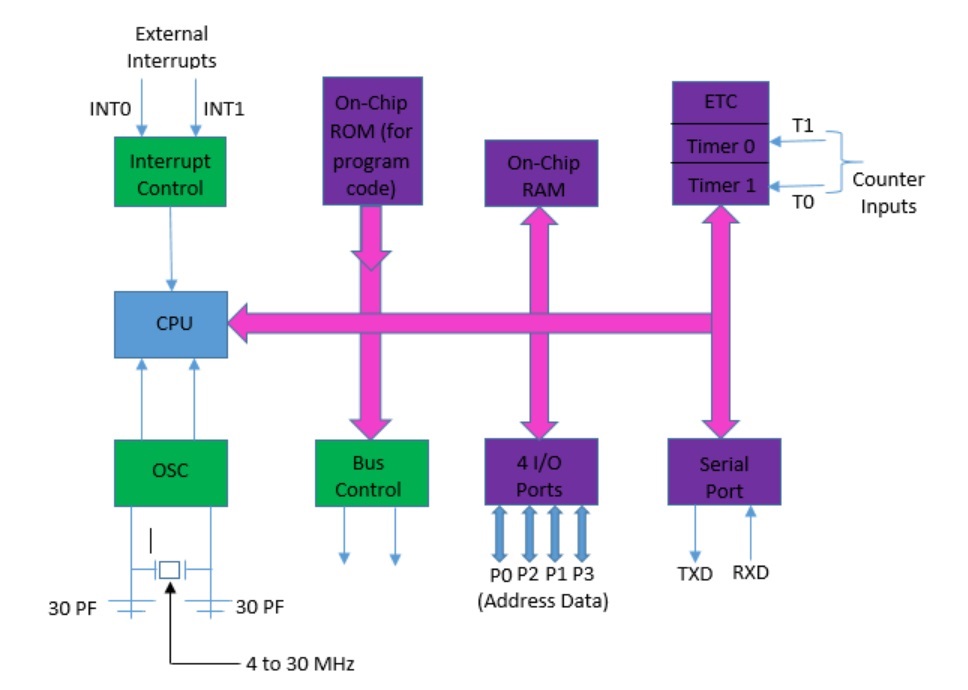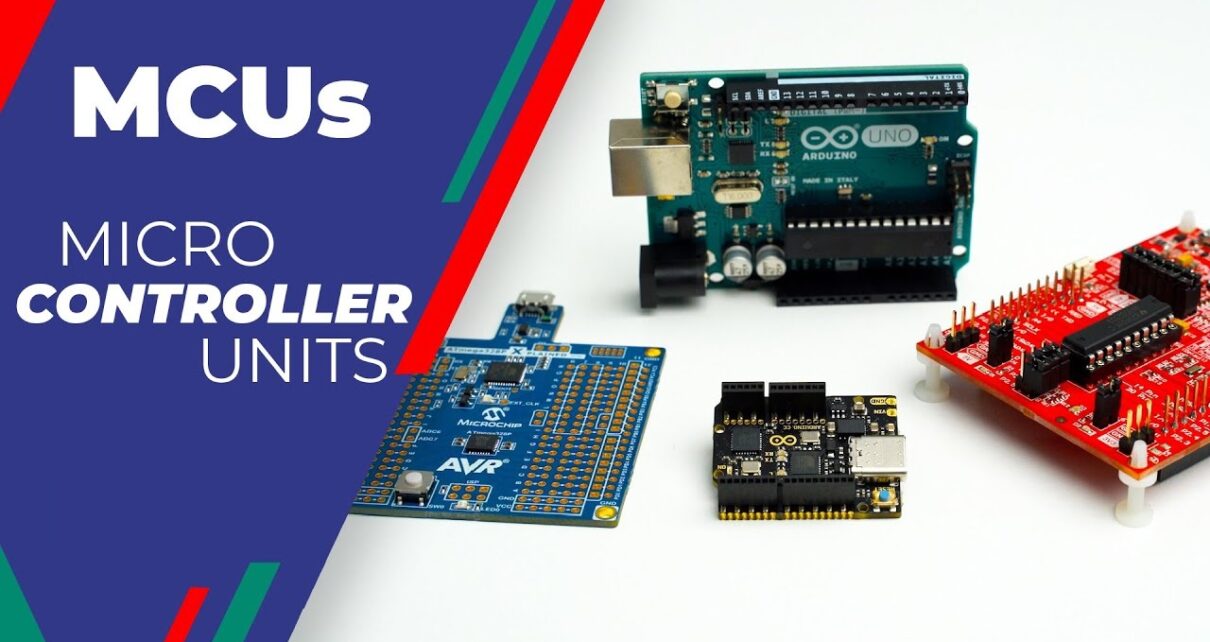Let’s see block diagram of microcontroller in detail. microcontroller is a compact electronic device that integrates a central processing unit (CPU), memory (both RAM and ROM), input/output (I/O) ports, and various peripherals onto a single integrated circuit (IC chip) for specified tasks. Unlike general-purpose microprocessors found in personal computers, microcontrollers are designed for specific tasks and are often programmed to execute a dedicated function. They are made for efficiency, tailored for real-time control and resource-constrained applications.
Block Diagram of Microcontroller:
A block diagram of a microcontroller provides a visual representation of the major components and their interconnections within the device. Here’s a generalized explanation of the typical blocks you might find in a microcontroller:

Central Processing Unit (CPU):
The CPU is the brain of the microcontroller, responsible for executing instructions and performing calculations. It interacts with other components to control the overall operation of the microcontroller.
Memory:
RAM (Random Access Memory):
Temporary storage for data and variables used during program execution. Allows for fast read and write operations.
ROM (Read-Only Memory):
Stores the firmware or program code that defines the microcontroller’s behavior. The content of ROM is typically not modifiable during normal operation.
Input/Output (I/O) Ports:
These ports allow the microcontroller to communicate with the external world. Inputs may include signals from sensors, switches, or other devices. Outputs are signals sent to control external devices like LEDs, motors, or other electronic components.
Peripherals:
Various peripherals are included to provide additional functionality.
Timers and Counters:
Used for time-sensitive operations and counting events.
Communication Interfaces:
UART (Universal Asynchronous Receiver-Transmitter), SPI (Serial Peripheral Interface), I2C (Inter-Integrated Circuit), etc., facilitate communication with other devices.
Analog-to-Digital Converter (ADC):
Converts analog signals (e.g., from sensors) into digital values for processing.
Digital-to-Analog Converter (DAC):
Converts digital signals to analog, useful in applications like audio processing.
Control Unit:
Manages the flow of data and instructions within the microcontroller. Decodes instructions from the program memory and coordinates the execution of tasks.
Clock Circuit:
Provides the timing signals necessary for the synchronization of various operations. The clock signal regulates the speed at which the microcontroller processes information.
Bus System:
The bus system comprises data buses and address buses. Data buses facilitate the transfer of data between different components. Address buses specify the location in memory for read or write operations.
Interrupt Controller:
Manages interrupts, allowing the microcontroller to respond to external events promptly. Interrupts can temporarily pause the execution of the main program to handle time-sensitive tasks.
This block diagram illustrates the modular and integrated nature of microcontrollers, where each block serves a specific purpose to ensure efficient processing and control. Keep in mind that the actual components and their organization may vary among different microcontroller architectures and models.
Universal NOR Gate Truth Table, Logic Circuit and IC PIN Diagram
Working of Microcontroller:
The working of a microcontroller block diagram involves the coordinated operation of several components to execute a set of instructions and perform specific tasks. Below is a general overview of the fundamental steps involved in the working of a microcontroller.
Power On:
When power is supplied to the microcontroller, it initializes its internal circuits. The power-on reset circuit ensures that the microcontroller starts in a known state.
Clock Oscillator:
The microcontroller relies on a clock oscillator to provide timing signals. The clock signal determines the speed at which the microcontroller processes instructions and performs operations.
Program Memory (ROM) Access:
The microcontroller fetches instructions from its program memory (typically ROM). The program memory contains the firmware or program code that dictates the microcontroller’s behavior.
Instruction Decoding:
The control unit decodes the fetched instructions to determine the specific operation to be performed. The decoded instructions are sent to the relevant components for execution.
Data Memory (RAM) Access:
If the instruction involves data manipulation, the microcontroller accesses data from its data memory (RAM). RAM is used for temporary storage of variables and data during program execution.
Execution of Instructions:
The central processing unit (CPU) executes the decoded instructions. Arithmetic and logic operations, data transfers, and control flow instructions are carried out as per the program logic.
Input/Output (I/O) Operations:
The microcontroller interacts with the external world through its I/O ports. Input operations involve reading signals from sensors or other devices connected to the microcontroller. Output operations involve controlling external devices like LEDs, motors, or displays.
Interrupt Handling:
The microcontroller monitors for interrupts, which are signals that temporarily halt the normal program flow to handle time-sensitive tasks. When an interrupt occurs, the microcontroller saves its current state, executes the interrupt service routine, and then returns to the main program.
Timer and Counter Operations:
Timers and counters are often used for time-sensitive tasks and event counting. They can trigger interrupts or perform specific actions when certain time intervals or counts are reached.
Communication with Peripherals:
Microcontrollers may communicate with other devices through various communication interfaces like UART, SPI, or I2C. This communication allows the microcontroller to exchange data with external components or devices.
Control Flow:
The control unit manages the flow of instructions, ensuring that the program executes in the correct sequence. Conditional branches and loops direct the program to different sections based on specific conditions.
Power Management:
Microcontrollers often include power management features to optimize energy consumption. Power-saving modes may be employed to reduce power when the microcontroller is idle.
Overall, a microcontroller involves fetching the instructions from memory or getting some interrupt from I/O then decoding it into command and then executing it in ALU and then storing the results in memory or performing respective I/O operation. This sequence of operations repeats continuously, allowing the microcontroller to perform its designated functions. The specific features and capabilities of a microcontroller depend on its architecture, model, and intended application. Microcontrollers are versatile devices that find application in a wide range of fields, from consumer electronics and automotive systems to industrial automation and IoT devices.
Types of Microcontrollers:
Here are the main types of microcontrollers and popular families in each category:
8-bit Microcontrollers
- Features: Operate on 8-bit data, suitable for simple applications.
- Applications: Small devices like home appliances, toys, simple automation.
- Examples: ATMega (used in Arduino), PIC, 8051.
16-bit Microcontrollers
- Features: Operate on 16-bit data, offering better performance than 8-bit MCUs.
- Applications: Automotive systems, industrial control, medical devices.
- Examples: MSP430 (Texas Instruments), PIC24.
32-bit Microcontrollers
- Features: Operate on 32-bit data, capable of higher processing power and memory handling.
- Applications: Advanced systems like smartphones, IoT devices, and multimedia applications.
- Examples: ARM Cortex-M, ESP32, STM32, Atmel SAM.
DSP Microcontrollers
- Features: Specialized for digital signal processing, offering high performance for real-time processing.
- Applications: Audio processing, communication systems, radar, and image processing.
- Examples: Texas Instruments C2000, Analog Devices Blackfin.
Low-Power Microcontrollers
- Features: Optimized for low power consumption, suitable for battery-operated devices.
- Applications: Wearable devices, IoT sensors, portable medical devices.
- Examples: MSP430, ARM Cortex-M0+, Atmel SAM L.
Wireless Microcontrollers
- Features: Built-in wireless communication capabilities such as Bluetooth, Wi-Fi, Zigbee.
- Applications: IoT, smart home devices, wireless sensors.
- Examples: ESP8266/ESP32, nRF52 (Nordic Semiconductor), CC26xx (Texas Instruments).
Popular Microcontroller Families:
ARM Cortex-M Series
- Manufacturers: STMicroelectronics, NXP, Texas Instruments, Microchip, and others.
- Features: 32-bit MCUs, widely used for embedded systems with real-time performance.
- Popular Models: STM32 (STMicroelectronics), LPC (NXP), SAMD (Microchip).
- Applications: Consumer electronics, industrial control, automotive systems.
PIC Microcontrollers (Microchip)
- Types: PIC10, PIC12, PIC16, PIC18 (8-bit); PIC24 (16-bit); PIC32 (32-bit).
- Features: Popular in industrial and hobbyist applications, easy to program and low-cost.
- Applications: Automotive, industrial automation, and basic control systems.
AVR Microcontrollers (Microchip)
- Popular Models: ATMega, ATTiny.
- Features: 8-bit architecture, widely used in the hobbyist community (e.g., Arduino).
- Applications: Robotics, home automation, basic IoT systems.
MSP430 (Texas Instruments)
- Features: Ultra-low power 16-bit microcontrollers.
- Applications: Battery-powered devices, sensors, and wearable electronics.
ESP8266/ESP32 (Espressif Systems)
- Features: 32-bit microcontrollers with integrated Wi-Fi and Bluetooth for IoT applications.
- Applications: Smart homes, IoT devices, wireless communication.
8051 Family (Intel and others)
- Features: One of the oldest and widely used 8-bit microcontrollers.
- Applications: Simple embedded systems, industrial control, and consumer products.
Renesas RX and RL78 Families
- RX Series: 32-bit MCUs for high-performance applications.
- RL78 Series: 16-bit MCUs for low-power applications.
- Applications: Industrial automation, automotive systems, home appliances.
Each microcontroller family is suited to different applications depending on the required performance, power consumption, and complexity of the task.
Applications of Microcontrollers:
Microcontrollers are found in various applications across diverse industries. Some notable examples include:
- Home Automation: In smart homes, microcontrollers control lighting systems, thermostats, and security cameras, enhancing convenience and security.
- Automotive: Modern vehicles use microcontrollers to manage engine control units (ECUs), airbags, anti-lock braking systems (ABS), infotainment, and more.
- Robotics: Microcontrollers are the brains behind robots, enabling them to navigate, interact with their environment, and perform specific tasks.
- IoT Devices: The Internet of Things relies heavily on microcontrollers to connect and control devices like smart appliances, wearables, and environmental sensors.
- Medical Devices: Microcontrollers drive a range of medical equipment, such as insulin pumps, heart rate monitors, and diagnostic devices, contributing to improved healthcare.
- Industrial Control: In the industrial sector, microcontrollers are essential for machinery control, process automation, and remote monitoring.
The Future of Microcontrollers
The future of microcontrollers is a promising one. As technology continues to evolve, we can expect several trends and innovations in this field:
- Increased Integration: Microcontrollers will become even more compact and power-efficient, with more functions integrated onto a single chip.
- IoT Growth: With the expansion of IoT, microcontrollers will play a pivotal role in connecting and managing an ever-growing number of devices.
- Artificial Intelligence: Integration of AI capabilities within microcontrollers will enable more intelligent and autonomous devices.
- Energy Efficiency: Energy-efficient designs will become increasingly important for battery-powered applications, leading to advancements in low-power microcontrollers.
- Security: As security concerns grow, microcontrollers will incorporate enhanced security features to protect data and privacy.
Conclusion:
Microcontrollers may be small in size, but their impact on our daily lives is immense. These unassuming devices are the driving force behind countless innovations, making our homes smarter, our cars safer, and our world more connected. As technology continues to advance, the role of microcontrollers will only become more significant, shaping the future of innovation and transforming the way we interact with the world around us.


Hi Abhishek,
Its very nice full of details article. Please keep on sharing the information with us.
Thanks